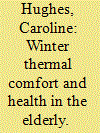|
|
|
Sort Order |
|
|
|
Items / Page
|
|
|
|
|
|
|
| Srl | Item |
| 1 |
ID:
168649


|
|
|
|
|
| Summary/Abstract |
Globally, building energy regulation has been an effective policy instrument for reducing energy use and carbon emissions. In Australia, the majority of regions address building performance through the National Construction Code. However, in 2004 the New South Wales government introduced a planning instrument called the ‘Building Sustainability Index’, known as BASIX. Until now there has been limited investigation of this sustainability index approach compared with addressing issues individually through building standards. This paper presents analysis of 94,648 building energy assessments in New South Wales and 190,286 from other Australian states to explore the impact of BASIX. The results show that the building code process delivers greater certainty and higher performance than through the sustainability index. The analysis shows that 58% of homes that pass BASIX would fail the National Construction Code for thermal comfort, and that the process of improving performance through the index is more cumbersome and slower than through individual building standards. Given the need to progressively increase house energy standards, governments should be seeking both certainty and higher performance outcomes. Failure to deliver community expected minimum performance risks locking in poor performance for long-life assets, and condemning a generation of households to unnecessarily higher energy bills.
|
|
|
|
|
|
|
|
|
|
|
|
|
|
|
|
| 2 |
ID:
115638


|
|
|
|
|
| Publication |
2012.
|
| Summary/Abstract |
There are many references to the WHO guidance on thermal comfort in housing, but not to the original source material. Based on archive material, this paper gives the evidential basis for the WHO guidance. It then reports on evidence that some groups may be more susceptible to high or low indoor temperatures than others. It examines different methods for measuring thermal comfort, such as air temperature measurement, assessing residents' perception, and predicting satisfaction. Resident's perception was used effectively in the WHO LARES project, showing that self-reported poor health was significantly associated with poor thermal comfort.
Tools to inform strategies directed at dealing with cold homes and fuel poverty are considered, including Energy Performance Certificates, Fuel Poverty Indicators, and the English Housing Health and Safety Rating System. Conclusions from a WHO Workshop on Housing, Energy and Thermal Comfort are also summarised.
The WHO view of thermal comfort, which is driven by protecting health from both high and low indoor temperatures, should be recognised in energy efficiency, fuel poverty and climate change strategies. While this is a major challenge, it could provide both health gains for individuals, and economic benefits for society.
|
|
|
|
|
|
|
|
|
|
|
|
|
|
|
|
| 3 |
ID:
109681


|
|
|
|
|
| Publication |
2011.
|
| Summary/Abstract |
In Europe, about 40% of the energy is consumed in buildings, more than by industry or transport. However, there is a great potential for energy savings in this field, often at little cost. A new European directive and several European standards, including the comfort standard EN15251, were created to develop comfortable and efficient buildings.
This paper presents the interaction of this specific standard with the application of energy efficiency regulations. In order to evaluate the impact of the EN15251 application in commercial buildings, a case study was analyzed using the dynamic simulation software TRNSYS-The Transient Energy System Simulation Tool. The building was set according to the standard conditions specified by the national regulation, and the assessment of comfort requirements of EN15251 was verified.
It was found that the current comfort requirements of the Portuguese regulation are not sufficient to achieve by themselves the comfort categories specified in the EN15251. About 55% of the comfort hours could not be assured. Furthermore, reaching the main comfort requirements (temperature/fresh air rates) of the EN15251 does not lead directly to the assessment of the corresponding categories. Results showed that the building stayed one comfort category behind from the desired when the correspondent operative temperatures were secured.
On the other hand, it was found possible to achieve the comfort categories by increasing the operative temperature ranges, imposed by the standard, about 1 °C. This has a negative consequence, which is the increment of energy consumption. However, there is a large room for maneuver to reduce this consumption into acceptable levels according to the EPBD.
|
|
|
|
|
|
|
|
|
|
|
|
|
|
|
|
| 4 |
ID:
180107


|
|
|
|
|
| Summary/Abstract |
This study tests the hypothesis that thermal comfort is socially constructed and as such, social norms will be effective in influencing Heating Ventilation and Air-Conditioning (HVAC) consumptions towards more sustainable levels. Within the framework of a randomized field experiment, the response of hotel guests to message prompts to set their room thermostat to a prescribed temperature was observed. Response behavior was monitored using temperature data logging devices which were placed in the hotel rooms. The data loggers recorded temperature readings from a sample size of 1047 guest stays. The findings suggest that social norms are effective in influencing hotel guests’ room temperature settings, indicating that thermal comfort may not only be a physiological and psychological need, but most importantly a social construct. The implication is that the future of the current unsustainable trend in resource consumption and Green House Gas pollution, driven by the increasing adoption of, and demands for, HVAC systems in buildings, can be modified towards more sustainable levels.
|
|
|
|
|
|
|
|
|
|
|
|
|
|
|
|
| 5 |
ID:
176670


|
|
|
|
|
| Summary/Abstract |
Fuel poverty has increasingly been associated with thermal discomfort, health related issues and winter deaths in the Global North because it can force families to choose between food and a warmer environment. Juxtaposing the concept of fuel poverty in rural tropical areas of the Global South, it is likely that a similar pattern between fuel poverty and heat related illnesses can be found. A recent study shows that between 1.8 and 4.1 billion people, especially in India, Southeast Asia and Sub-Saharan Africa will need indoor cooling to avoid heat related health issues. This paper aims to address a blind spot in the literature on the links between fuel poverty, thermal comfort and cooling strategies in the Brazilian Amazon.
|
|
|
|
|
|
|
|
|
|
|
|
|
|
|
|
| 6 |
ID:
169729


|
|
|
|
|
| Summary/Abstract |
There is said to be a strong relationship between low winter fuel consumption and increased cold-related morbidities and mortalities in the elderly. However, no study has so far investigated baseline domestic thermal conditions, energy and health in this demographic - a crucial gap given an ageing population. Hence we examine, for the first time, the validity of current thermal comfort standards and World Health Organisation minimum temperature thresholds in the 65 + demographic, through a longitudinal study of thermal conditions in homes of the elderly. We cover two typical winters using repeated monthly surveys and continuous temperature monitoring in living and bed rooms. Results demonstrate that the widely used ISO7730 model significantly underpredicts comfort in this demographic. We use our data to create a new model for the elderly, with a 40% lower error rate. Using calibrated computer models, we demonstrate that our model predicts a 44% reduction in winter heating demand, compared to the current model. Finally, our data provides little evidence for an association between low indoor temperature and healthcare visits for a variety of morbidities. These results question current assumptions around thermal comfort and health in the elderly, with potential implications for health and energy policy.
|
|
|
|
|
|
|
|
|
|
|
|
|
|
|
|
|
|
|
|
|